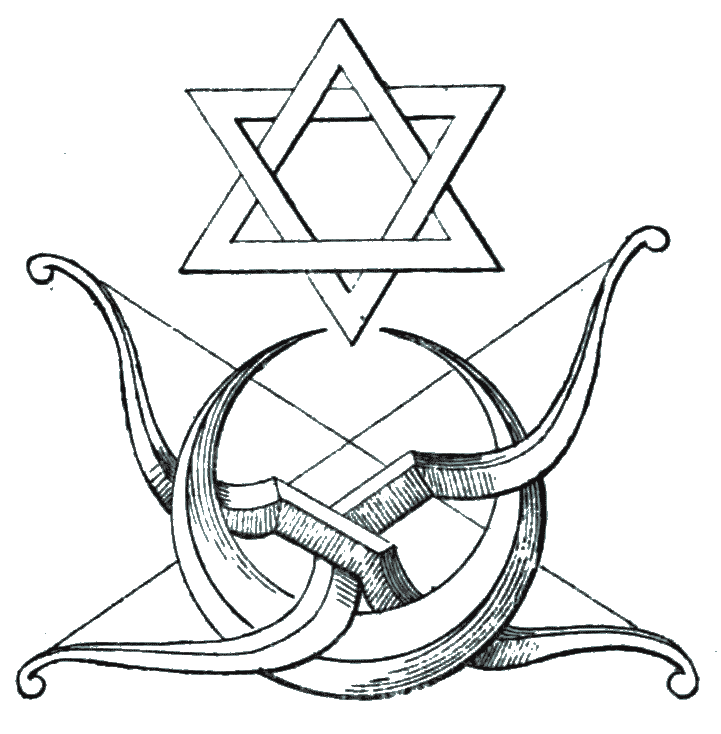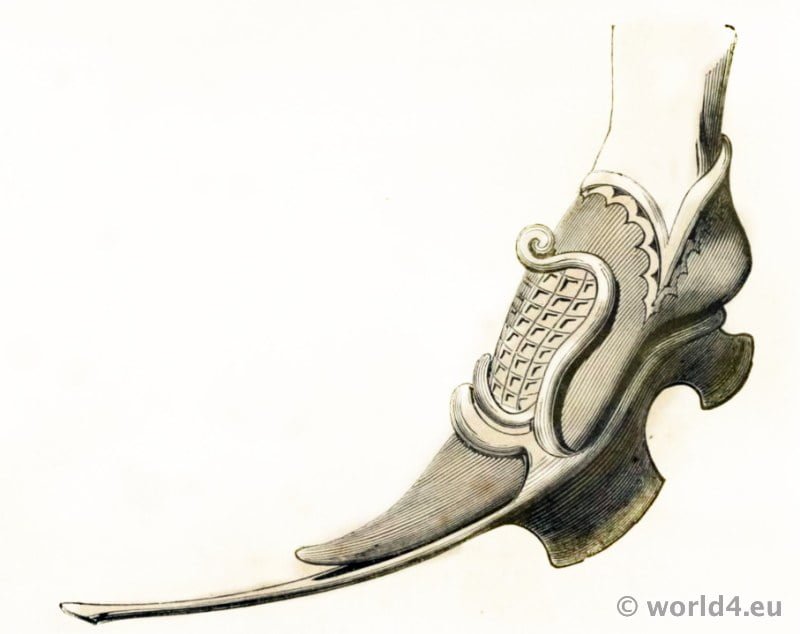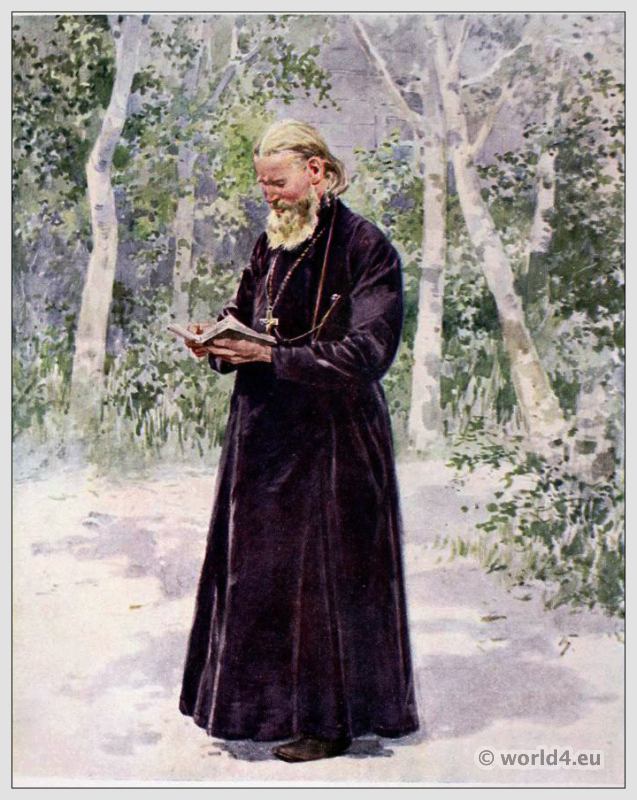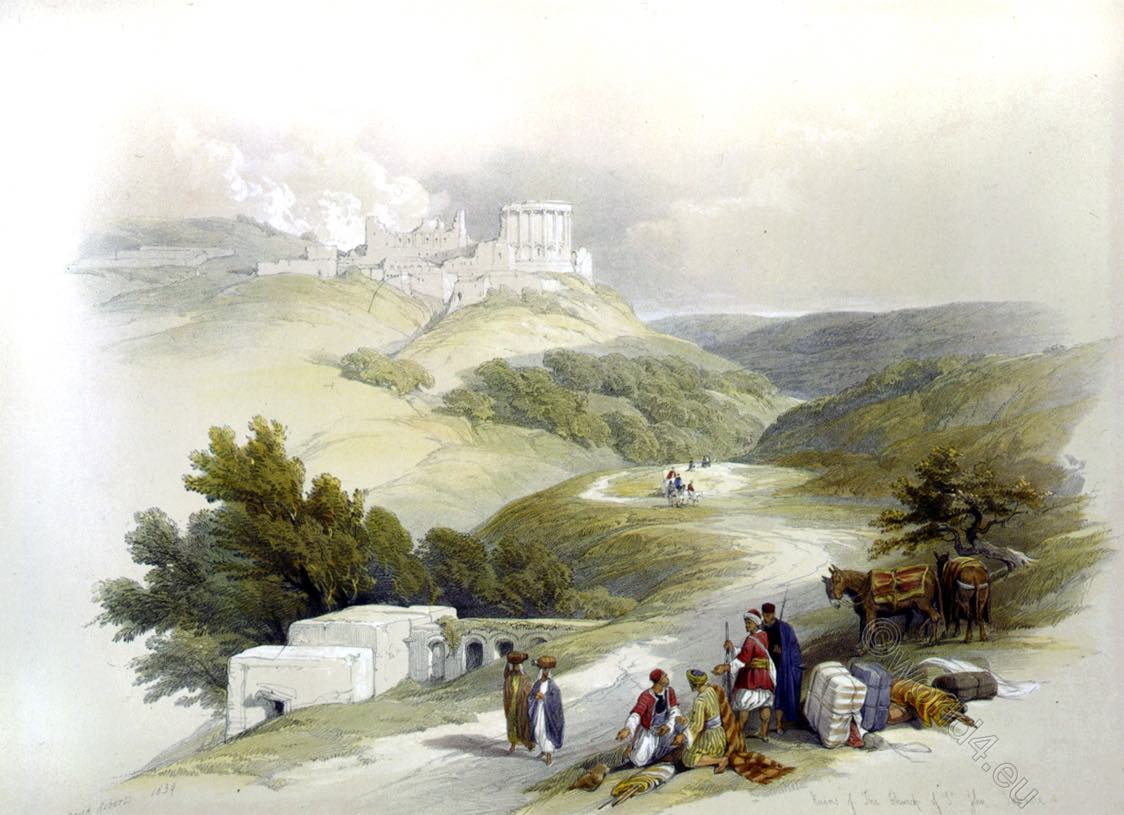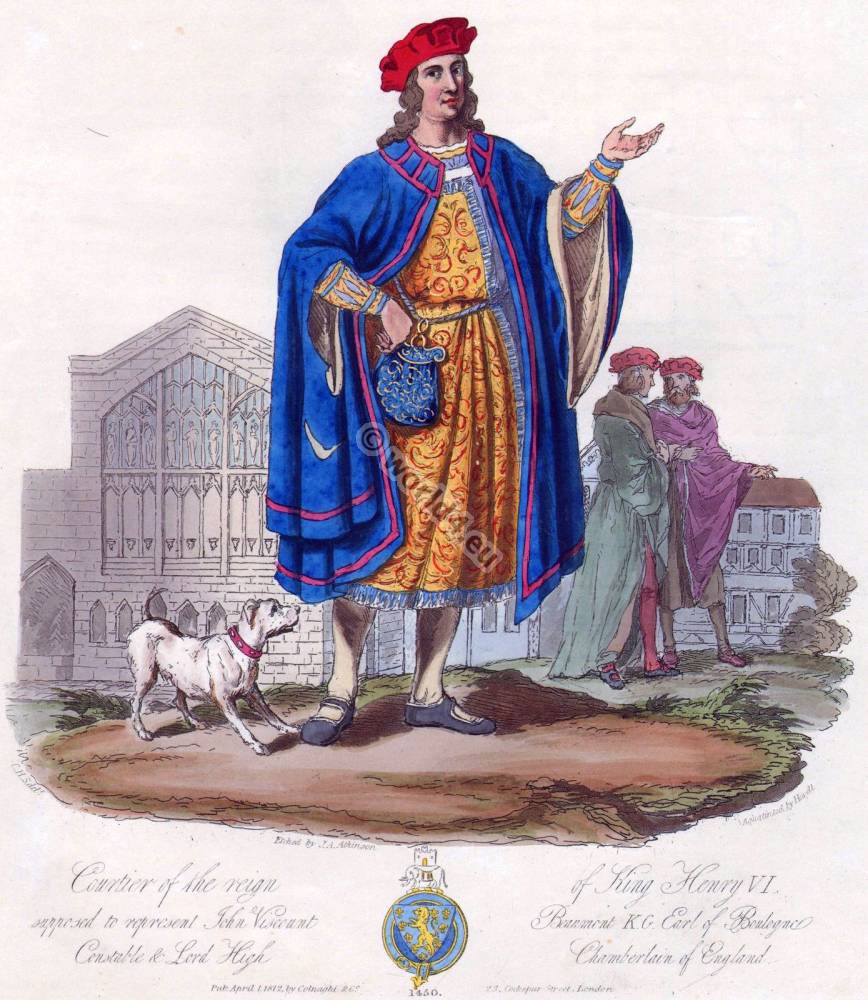Early monastic life
Mar Saba, center of earlier Greek Hymns, Odes and Canons, and of the Quasi-Ecclesiastic Hymn.
The Mar Saba Monastery
The Monastery of Mar Saba (Lawra*) is in the wilderness of Judea, only about ten miles southeast of Jerusalem, and not far from the western shores of the Dead Sea. This monastery still inhabited, stands on a lofty cliff, overhanging the Kedron Valley.
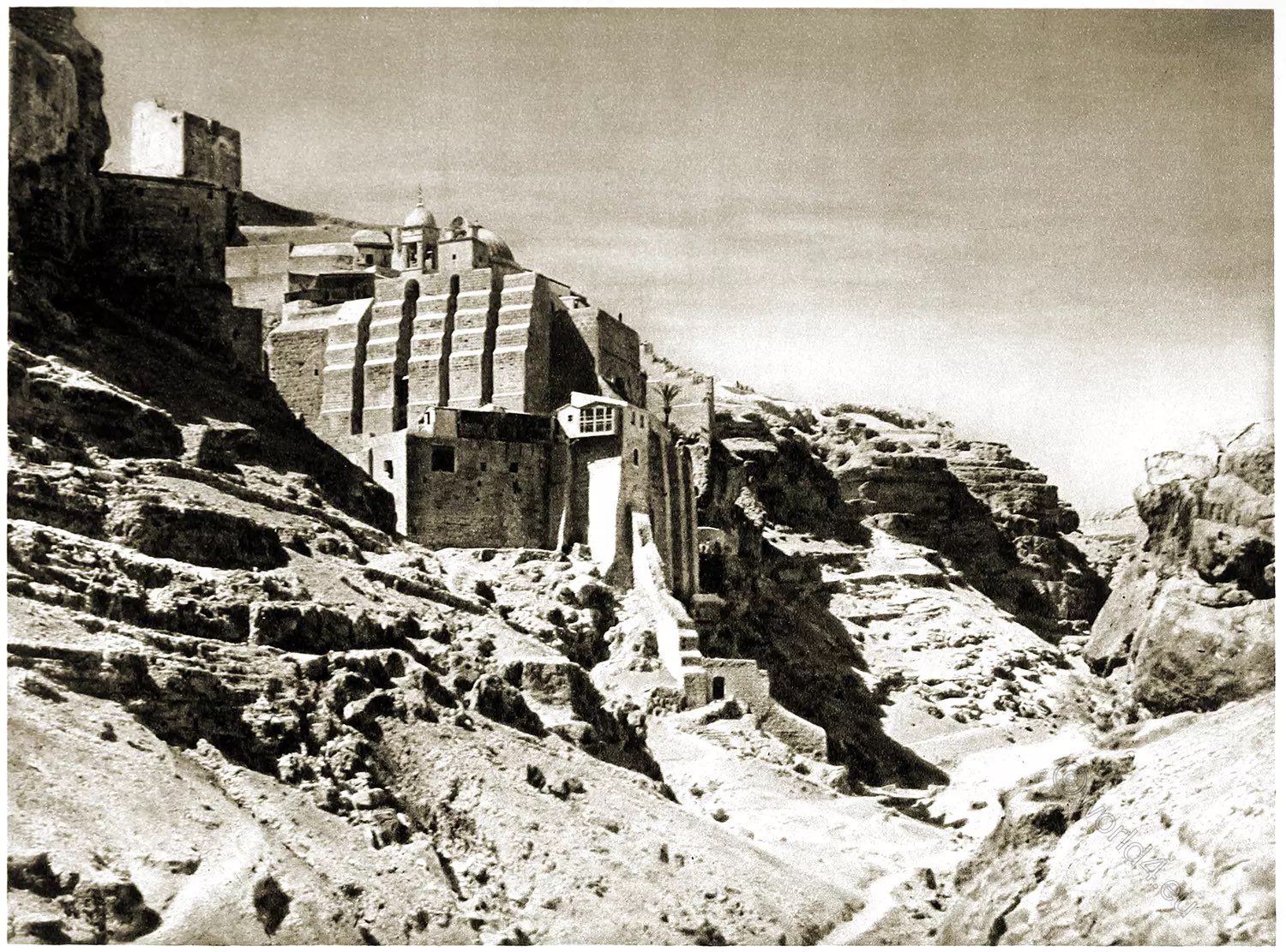
One wonders how the monastery is able to cling, like an eagle’s nest, to the face of the cliff. The chapel is cut out of the solid rock, and there, for more than a thousand years the monks have held their daily and nightly services.
From this monastery has come much of the best literature of the ancient Greek church.
*) A lavra, lawra or laura (Greek: Λαύρα) is a type of monastery consisting of a group of cells or caves for hermits, with a church and sometimes a refectory in the centre. Lavra monasteries exist in the Orthodox and other Eastern Christian traditions; the name is also used by some Catholic communities. In Greek, the term originally meant a narrow lane or alleyway in a town.
The hymn writers of Mar Saba
The circumstances which brought the hymn writers to this spot are most unusual. Early in the seventh century, today’s Syrian capital, the beautiful city of Damascus had been besieged by the Arabs, and after a long fierce struggle the invaders carried the assault, and entered the city in triumph.
These Arabs were fierce warriors, but they knew nothing about governing cities. They drafted some of the older inhabitants to help them in this. The father *) of John of Damascus was selected to govern the country for them.
*) Sarjun (Sargun) ibn Mansur was a high-ranking Christian official at the Umayyad court in the 7th century. He is referred to as Sergios, son of Mansur, in the Greek Chronicle of Theophanes, one of the most important sources for the second half of the 7th century regarding the Arab conquest in the eastern Mediterranean.
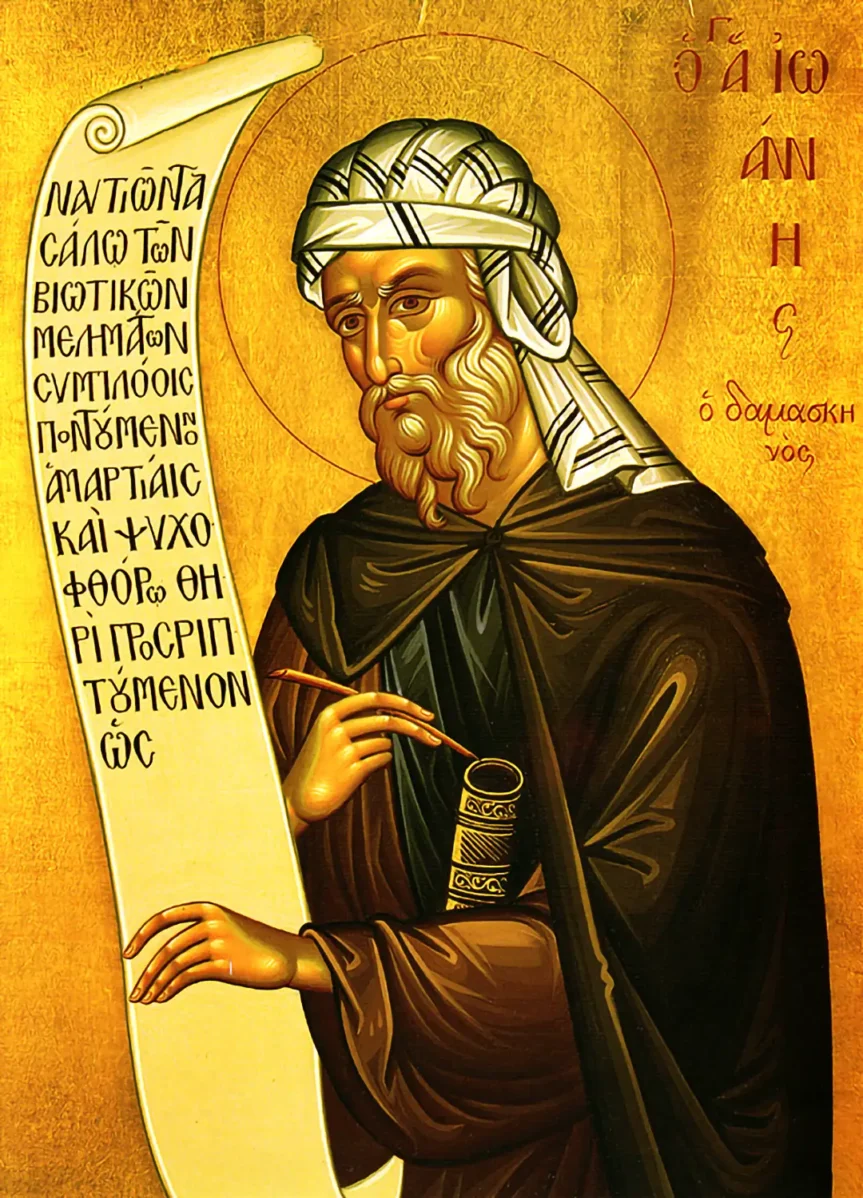
John of Damascus
Like Joseph in Egypt, this man was placed in a very high position by the conquering race and proved himself worthy of their trust. He continued though, to be an earnest Christian even to the extent of causing possible trouble with the Mohammedan rulers, as was shown in his insistence upon having his son John *) baptised. He devoted his great wealth to the ransom of Christian slaves who were brought in great numbers by the Mohammedans to the slave market of Damascus.
*) John of Damascus (Latin Ioannes Damascenus) around 650 in Damascus; † 4. December before 754 in Mar Saba) with the surname Chrysorrhoas (Χρυσορρόας = “the one who exudes gold”), Greek Ἰωάννης ὁ Δαμασκηνός, was a Syrian theologian and church father. In the Roman Catholic Church, he is considered the last of the Church Fathers and has been honoured as a Doctor of the Church since 1890. He is said to have grown up in a distinguished Christian family in Damascus. He spent the second half of his life as a monk in the Mar Saba monastery south-east of Jerusalem.
Cosmas of Maiuma
One day while walking through the slave market he was attracted to a fair haired Italian youth, a scholarly Italian-Greek prisoner of war, a monk named Cosmas. This lad seemed sad and hopeless, for he was afraid that he might be sold to some rough task master and never again have the opportunity to teach or read.
However, as in the fairy tale, he was lucky enough to be bought by Sarjun ibn Mansur as a tutor for his own son John and an adopted poor boy called Cosmas, who was taken into the household as a companion for John. Years later, this Italian slave tutor, gained his freedom and retired to the monastery of Mar Saba.
Cosmas, *) the foster brother of John of Damascus followed the tutor to Mar Saba to become a monk. John of Damascus had stayed in the city and had proved himself so useful to the Mohammedan Government that after his father’s death he was given the position as chief councillor to the Khalifah or Caliph.
*) Cosmas of Maiuma, also known as Cosmas of Jerusalem, Cosmas the Melodite, Cosmas the Poet and Cosmas Hagiopolite (Jerusalem, c.706 – Maiuma, c.760), was a hymnographer and bishop of the Orthodox Church, which considers him a saint, as does the Catholic Church. His feast day is celebrated in the West on 12 October, and in the East on the 14th of the same month.
As Daniel was not without enemies in Babylon, so too, John did not lack for enemies among the Mohammedans. He was envied by them for his position in the government and a plot deprived him of his position and, in addition, he was severely punished.
The monk John of Damascus
The Khalif found shortly afterward that John had not betrayed the government but that a plot had been hatched against him. His old position was offered him; but something had transpired in the meanwhile. He longed for the companionship of his foster-brother Cosmas, and his old tutor, so he had determined to leave Damascus to join them at the Monastery of Mar Saba.
Here in the wilderness of Judea, where no grass or tree grows and only the howling of wolves or the ravenous starlings break the silence, the monks by prayer and fasting sought to serve God. John was so distinguished a novice, that none of the monks wanted to take him in hand. Finally, an old monk taught him that silence and obedience were the first duties of a monk.

For months John obeyed in silence. Then when one of the monks died, John composed a funeral hymn, wrote the words and music, and sang it in his cell. It may have been a dirge to his former tutor Cosmas, who had retired to this monastery years before. This is just a conjecture on my part. The monks recognised his gift, and gave him freedom to write hymns and to preach on missions throughout Syria.
Iconoclasts
As a particularly staunch opponent of the iconoclasts, *) John of Damascus protested defiantly against the excesses of the iconoclasts and wrote poems and treatises in defence of images, which earned him the title “Doctor of Christian Art”.
*) Iconoclasm (from the ancient Greek ἡ εἰκών he eikón “the image, likeness” and τὸ κλάσμα tó klásma “the broken, fragment”, this from κλάω kláo “I break”), also known as iconoclasm, is the destruction of images or monuments of religious, cultural or political relevance. (Source: Wikipedia)
John of Damascus and his foster-brother were the best of friends at the monastery, where it is said, ‘they, excited each other to hymnology, and corrected and polished each other’s compositions.” *) At the comparatively late period of life he was ordained Priest of the Church of Jerusalem, and died in the convent of Mar Saba about 780 A.D. John of Damascus is known also as St. John of Jerusalem.
*) Bernhard Pick: “Hymns and Poetry of the Eastern Church” – p. 133.
A nest of singing birds
The final link of the story is wrought by the nephew of John Damascus, Stephen (Stephen the Sabaean), by name, who came into the monastery when he was only ten years old, and stayed there all his life, dying at the age of seventy. John, his foster brother Cosmas (Cosmas of Maiuma), and his nephew Stephen (Stephen the Sabaean), fellow monks end fellow poets formed here “a nest of singing birds”. (1)
“Surely the writers must have had their visions and ecstasies, like Longfellow’s monk, breaking in on the dull monotony of their narrow life, or vvas it that the very limitations of their earthly horizon brought the heavenly near?” (2)
We shall now consider their individual contributions. In this lonely and desolate spot, seven hundred feet above the Dead Sea, an outpost of Eastern Christendom, this group of men wrote hymns to the praise of God, which ever since have made music for the Christian church.
Cosmas of Maiuma
St. Cosmas, often called “the Melodist”, holds second place among Greek Ecclesiastical poets. He was consecrated bishop of Majuma, near Gaza, in 745 A.D. by John, patriarch of Jerusalem, so that he is known also as St. Cosmas of Jerusalem. He died of old age, about 760 A.D. The estimation in which he was held is indicated by these lines in the hymn commemorating his day in the calendar of the Greek church on the 14th of October:
“Where perfect sweetness dwells, is Cosmas gone; But his sweet lays to cheer the church live on.” (3)
(1) Gillman, F. J. “Evolution of the English Hymn”, p.
(2) Campbell, Duncan “Hymn and Hymn Makers”, p. 8.
(3) Pick, Bernhard “Hymns and Poetry of the Eastern Church”, p. 133.
The great works of this poet are his *Canons for the Festivals. Often the *Odes of the several Canons are interwoven, brotherlike, with those of St. John of Damascus and sung alternately in the service of the church. He has Canons on “Purification”, “Transfiguration”, “Palm Sunday”, and on his favorite Father Gregory Nazianzen. His canon for **Christmas Day is perhaps the finest and may justly be ranked with the rival composition of St. John of Damascus, The ancient fame of the poems of this poet was great.
“He is the most learned of the Greek church poets; and his fondness for types, boldness in their application and love of aggregating them, make him the Oriental Adam of St. Victor. It is owing partly to a compressed fulness of meaning, very uncommon in the Greek poets of the church, partly to the unusual harsimess and contraction of his phrases, that he is the hardest of ecclesiastical bards to comprehend.” (1)
St. John of Damascus has the honor of being the greatest theological instructor of the Eastern Church in addition to being its greatest poet. His chief work, “The Fountain of Knowledge” is a complete systematic presentation of the theology of the Greek Church. A Latin translation of the twelfth century influenced the scholasticism of the West.
* For explanation, see pp, 28-51
** For words, see p. 97
(1) Neale, J. M. “Hymns of the Eastern Church”, p. 80-81
As a poet, he gave great impetus to Greek hymnology. His impress on the Greek Service Books is distinct and deep; it affected the music as well as the poetry. The arrangement of the’ *Octoechus in accordance with the Eight Tones was his work, and it originally contained no other Canons than his. Mis greatest achievements are his Canons on the great Festivals. The Canons found under the name of John Arklas are usually attributed to St. John of Damascus, also those under the name of John the Monk.
His three great canons are those on Easter, the Ascension, and St, Thomias ‘ Sunday. *) Many hundreds of years before the Christmas “Adeste Fideles” of the Latin West was written, John of Damascus composed his Greek “Adeste Fideles” for a Resurrection Song in Jerusalem.
*) The Orthodox Church celebrates St Thomas the Apostle on two days a year: once as a movable memorial day on the Sunday after Easter, which is therefore also called St Thomas Sunday; and once as an immovable memorial day on 6 October.
The first two lines of Ode 1 of our saint’s canon for St. Thomas’ Sunday begin: “Come, ye faithful, raise the strain
Of triumphant gladness!” *)
*) Neale, J.M.- “Hymns of the Eastern Church”, p. 80-81.
Canon for Easter Day
J . M. Neale has translated from the Greek the “Canon for Easter Day”, “Canon for St. Thomas’ Sunday”, the “Strichera of the Last Kiss”, and “Idiomela of all Saints”. It is Ode 1 of the “Canon for Easter Day” that is the source of one of our greatest Easter hymns: “Tis the Day of Resurrection”.
An eloquent description by Arthur Penchyn Stanley (1815-1881; dean of Westminster, of the circumstances under which the “Canon of Easter Day”, called the Golden Canon, or the Queen of Canon is sung is worthy of quoting:
The scene is at Athens. “As midnight approached, the Archbishop, with his priests, accompanied by the King and Queen, left the Church, and stationed themselves on the platform, which was raised considerably from the ground, so that they were distinctly seen by the people.
Every one now remained in breathless expectation, holding their unlighted tapers in readiness when the glad moment should arrive, while the priests still continued murmuring their melancholy chant in a low half whisper.
Suddenly a single report of a cannon announced that twelve o’clock had struck, and that Easter day had begun; then the old Archbishop elevating the cross, exclaimed in a loud exulting tone, ‘Christos anesti!’ ‘Christ is risen!’ and instantly every single individual of all that host took up the cry, and the vast multitude broke through and dispelled forever the intense and mournful silence which they had maintained so long, with one spontaneous shout of indescribable joy and triumph, ‘Christ is risen!’ ‘Christ is risen!‘
At the same moment, the oppressive darkness was succeeded by a blaze of light from thousands of tapers, which, communicating one from another, seemed to send streams of fire in all directions, rendering the minutest objects distinctly visible, and casting the most vivid glow on the expressive faces full of exultation of the rejoicing crowd; bands of music struck up their gayest strains; the roll of the drum through the town, and further on the pealing of the cannon announced far and near these ‘glad tidings of great joy’; while from hill and plain, from the sea-shore and the far olive-grove, rocket after rocket ascending to the clear sky, answered back with their mute eloquence, that Christ is risen indeed, and told of other tongues that were repeating those blessed words, and other hearts that leap for joy; everywhere men clasped each other’s hands, and congratulated one another, and embraced with countenances beaming with delight, as though to each one separately some wonderful happiness had been proclaimed;- and so in truth it was; – and all the while, rising above the mingling of many sounds, each one of which was a sound of gladness, the aged priests were distinctly heard chanting forth a glorious old hymn of victory in tones so loud and clear, that they seemed to have regained their youth and strength to tell the world how ‘Christ is risen from the dead, having trampled death beneath His feet, and henceforth they that are in the tombs have everlasting life,’” (1)
(1) Neale, J. M. “Hymns of the Eastern Church”, p. 59-60.
Stephen the Sabaean
Stephen came under the influence of Cosmas and John and was guided and inspired in his literary style so that he too became a poet. The most beautiful of his hymns is the well known “Art thou weary, art thou languid?” The English version by Dr. Neale is so free a translation from the Greek, that it almost deserves to be classed as an original hymn. Stephen, no doubt, received his inspiration for his poem from the bells in the belfry of the Monastery of Mar Saba, which sent forth their beautiful chimes to gladden the hearts of pilgrims who, “weary and languid” made their way through the desolate wilderness of Judea.
“One day Dr. Neale found, in the course of his researches, the words of Stephen’s song, sung in old Mar Saba, more than eleven hundred years before. From these words in a dust-covered, ponderous, old Greek quarto, Dr. Neale has given to the Christian Church this hymn. It can hardly be called a translation, but rather a re-creation, for it has in it not only the experiences of Stephen the Sabaite, but also those of Dr. Neale, – combined, these make a text so simple, so dramatic, that it is one of the greatest English hymns. (1)
(1) Smith, H. Augustine, “Lyric Religion”, p. 33.
So from the grim walls of this remote monastery have come hymns of confidence, faith, and triumphant gladness. Much of the best literature of the ancient Greek Church issued from this lonely and desolate spot. St. John of Damascus and St. Cosmas were the foremost in the roll of the Greek ecclesiastical poets. The impress of the former on the Greek Service Books is distinct and deep. It affected the music as well as the poetry. St. John had a principal share in the arrangement of the Octoechus, which contain the Sunday services of the Eastern Church. The oldest manuscripts of the Octoechus contains no other Canons than his. Other Canons are found in the Menaea, and Pentecost arion.
The latter celebrate the grand themes of Christmas, the”Theophany” (Baptism of Christ), Pentecost, Easter, St Thomas’ Sunday, and the Ascension, Nowhere are the best characteristics of the Greek Canon exhibited so splendidly as in his “Easter Canon”, known as the “King of Canons”. It is the grandest piece in Greek sacred poetry.
The works of St Cosmas are his canons for the feasts. Cosmas’ poems were widely known and numerous commentaries were written on them.
The imagination is stimulated when one reflects upon this little group of men who, twelve hundred years ago set in motion waves of deep Christian feeling which have widened in their sweep until now, in every continent they make music for the Christian Church. Surely, these recluses must have had their visions and ecstasies.
Source: Monastic centers of hymn writing and their influence on hymnody, by Allan Fraser. Thesis (M.A.)–Boston University, 1932
Continuing
Discover more from World4 Costume Culture History
Subscribe to get the latest posts sent to your email.

